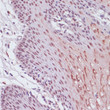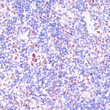| Tissue Specificity | Ubiquitously expressed. |
| Post Translational Modifications | Acetylated by KAT8 in epithelial but not in mesenchymal cells, thereby regulating the epithelial-to-mesenchymal transition. Acetylation by KAT8 reduces KDM1A association with nucleosomes, thereby decreasing histone H3 demethylation, leading to transcription activatio of target genes. Polyubiquitinated by JADE2.which leads to its proteasomal degradation. Deubiquitinated by USP38.preventing it from degradation by the 26S proteasome. |
| Function | Histone demethylase that can demethylate both 'Lys-4' (H3K4me) and 'Lys-9' (H3K9me) of histone H3, thereby acting as a coactivator or a corepressor, depending on the context. Acts by oxidizing the substrate by FAD to generate the corresponding imine that is subsequently hydrolyzed. Acts as a corepressor by mediating demethylation of H3K4me, a specific tag for epigenetic transcriptional activation. Demethylates both mono- (H3K4me1) and di-methylated (H3K4me2) H3K4me. May play a role in the repression of neuronal genes. Alone, it is unable to demethylate H3K4me on nucleosomes and requires the presence of RCOR1/CoREST to achieve such activity. Also acts as a coactivator of androgen receptor (AR)-dependent transcription, by being recruited to AR target genes and mediating demethylation of H3K9me, a specific tag for epigenetic transcriptional repression. The presence of PRKCB in AR-containing complexes, which mediates phosphorylation of 'Thr-6' of histone H3 (H3T6ph), a specific tag that prevents demethylation H3K4me, prevents H3K4me demethylase activity of KDM1A. Demethylates di-methylated 'Lys-370' of p53/TP53 which prevents interaction of p53/TP53 with TP53BP1 and represses p53/TP53-mediated transcriptional activation. Demethylates and stabilizes the DNA methylase DNMT1. Demethylates methylated 'Lys-42' and methylated 'Lys-117' of SOX2. Required for gastrulation during embryogenesis. Component of a RCOR/GFI/KDM1A/HDAC complex that suppresses, via histone deacetylase (HDAC) recruitment, a number of genes implicated in multilineage blood cell development. Facilitates epithelial-to-mesenchymal transition by acting as an effector of SNAI1-mediated transcription repression of epithelial markers E-cadherin/CDH1, CDN7 and KRT8. Required for the maintenance of the silenced state of the SNAI1 target genes E-cadherin/CDH1 and CDN7. |
| Protein Name | Lysine-Specific Histone Demethylase 1aBraf35-Hdac Complex Protein Bhc110Flavin-Containing Amine Oxidase Domain-Containing Protein 2Histone H3-Dimethyl-L-Lysine(4 Fad-Dependent Demethylase 1a |
| Database Links | Reactome: R-HSA-3214815Reactome: R-HSA-3214842Reactome: R-HSA-5625886Reactome: R-HSA-8943724Reactome: R-HSA-9018519Reactome: R-HSA-9029569Reactome: R-HSA-9679191Reactome: R-HSA-983231 |
| Cellular Localisation | NucleusChromosomeAssociates With Chromatin |
| Alternative Antibody Names | Anti-Lysine-Specific Histone Demethylase 1a antibodyAnti-Braf35-Hdac Complex Protein Bhc110 antibodyAnti-Flavin-Containing Amine Oxidase Domain-Containing Protein 2 antibodyAnti-Histone H3-Dimethyl-L-Lysine(4 Fad-Dependent Demethylase 1a antibodyAnti-KDM1A antibodyAnti-AOF2 antibodyAnti-KDM1 antibodyAnti-KIAA0601 antibodyAnti-LSD1 antibody |
Information sourced from Uniprot.org














